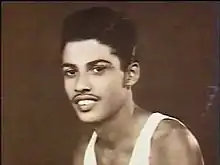 | |
| Personal information | |
|---|---|
| Nationality | Sri Lankan |
| Born | 21 May 1936 |
| Died | 15 December 1974 (aged 38)[1] |
| Sport | |
| Country | Sri Lanka |
| Sport | Track and field |
| Event(s) | 5000 meters, 10,000 meters Long-distance running |
| Updated on 15 October 2015. | |
Ranatunge Koralage Jayasekara Karunananda (21 May 1936[2] – 15 December 1974) was a Sri Lankan athlete. He was a long distance runner and represented the country during the 1960s and 1970s. Karunananda competed in the 10,000 meter race last at the 1964 Summer Olympics in Tokyo.[3][4]
1964 Olympics
Karunananda represented Ceylon (as Sri Lanka was named at the time) in the 1964 Summer Olympics Men’s 5000 meters and Men’s 10,000 meters competitions. In the 10,000 meter race, Karunananda was soon overtaken by the leading athletes and was lapped a total of four times until the winner of the race, Billy Mills of the United States, broke the tape to finish the race. Karunananda continued to run after the others had finished the race. At first, spectators started to jeer at him, but when he eventually finished the race, he was met with cheers and applause.[5][6][7]
Two days later, Karunananda finished second from last in the heats of the 5000 meters, well behind the other runners but a minute ahead of the last runner from Vietnam.
Legacy
Japanese reporter Haruo Suzuki was one of the first reporters to have an interview with Karunananda following the race. Instantly, Japanese media started to portray Karunananda as a hero. When questioned, Karunananda told reporters: "The Olympic spirit is not to win, but to take part. So I came here. I took part in the 10,000 meters and completed my rounds."[6]
He was flooded with small gifts which Japanese fans usually send to their heroes.[8] The Olympic Village office asked him to come down and collect his mail because the sack was too big for them to deliver.[9] "I saw you on television running all one and I couldn't keep back my tears", a letter from a young housewife said. "I felt I was feeling for the first time the true Olympic spirit".[8]
Karunananda's Olympic story has been entered into Japanese school textbooks titled 'Uniform Number 67', 'Bottom Ranked Hero'.[3]
Death
In 1974, Karunananda had been offered a job in Japan in appreciation of his deed. A few days before leaving Sri Lanka, however, Karunananda mysteriously died, drowning in the Namal Oya tank. Some theories say that he just disappeared.[10] Karunananda’s wife suffered a mental breakdown following her husband’s death and the family was forced onto the streets. Later, one of the relatives offered to fund and take care of his family. The Sri Lankan government did not acknowledge his legacy or look after his family.[3]
References
- ↑ Biography of Ranatunge Karunananda
- ↑ "Ranatunge Karunananda". SportsReference.com. Archived from the original on 18 April 2020. Retrieved 27 May 2013.
- 1 2 3 "Athletics: The inside story of 'Marathon Karu's' legend". Sunday Times. 2012-09-15. Archived from the original on 17 September 2012. Retrieved 2013-05-27.
- ↑ "Ranatunge J. KARUNANANDA - Olympic Athletics | Sri Lanka". International Olympic Committee. 2016-06-13. Retrieved 2017-09-09.
- ↑ "R.J.K. Karunananda: A forgotten hero". The Island. Retrieved 2013-05-27.
- 1 2 "Sri Lanka's unsung Karunananda, a hero in Tokyo!". The Island. Retrieved 2013-05-27.
- ↑ KARUNANANDA - THE MOST SPIRITED LOSER, retrieved 2023-05-26
- 1 2 Runner first with fans, Arizona Daily Star, 20 October, 1964 (via newspapers.com)
- ↑ Magnificent - but Britain can never repeat it, Chris Brasher, The Observer, 25 October 1964 (via newspapers.com)
- ↑ "We don't need another hero!". Daily News. 2010-05-05. Archived from the original on 9 June 2010. Retrieved 2013-05-27.
External links
- Ranatunge Karunananda at Olympedia
- Egi, Shingo (8 May 2012). "Zekken 67 hashiritsuzukeru". Asahi Shimbun (in Japanese). Retrieved 27 May 2013.